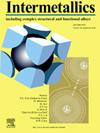Structural-weakening mapping to seismic-like slip avalanches in bulk-metallic glasses
IF 4.3
2区 材料科学
Q2 CHEMISTRY, PHYSICAL
引用次数: 0
Abstract
“Smaller is softer” mainly refers to the reverse size dependence of plasticity for bulk-metallic glasses (BMGs). Here, we report experimental results showing that “flatter acts more ductile”. Specifically, by choosing low aspect ratios for the samples, like 1:2, in compression experiments it is possible to eliminate catastrophically large (system-spanning) slips that are often seen for BMG samples with large aspect ratios of 3:1, 2:1, and 1:1. Moreover, for BMG samples with an aspect ratio of 1:2, multiple parallel shear bands produce self-similar slip avalanches, whose size distribution follows the stress-integrated power-law exponent of around 1.0. This exponent value, agrees with the prediction of mean field theory for a near-zero structural-weakening factor, modeling ductile behavior. The absence of structural weakening for the aspect ratio of 1:2 suggests that this aspect ratio may be preferable for some applications where large slips are undesirable because they lead to jerky deformation behavior and are difficult to control.
结构削弱映射到块状金属玻璃中的地震样滑移雪崩
本文章由计算机程序翻译,如有差异,请以英文原文为准。
求助全文
约1分钟内获得全文
求助全文
来源期刊

Intermetallics
工程技术-材料科学:综合
CiteScore
7.80
自引率
9.10%
发文量
291
审稿时长
37 days
期刊介绍:
This journal is a platform for publishing innovative research and overviews for advancing our understanding of the structure, property, and functionality of complex metallic alloys, including intermetallics, metallic glasses, and high entropy alloys.
The journal reports the science and engineering of metallic materials in the following aspects:
Theories and experiments which address the relationship between property and structure in all length scales.
Physical modeling and numerical simulations which provide a comprehensive understanding of experimental observations.
Stimulated methodologies to characterize the structure and chemistry of materials that correlate the properties.
Technological applications resulting from the understanding of property-structure relationship in materials.
Novel and cutting-edge results warranting rapid communication.
The journal also publishes special issues on selected topics and overviews by invitation only.
 求助内容:
求助内容: 应助结果提醒方式:
应助结果提醒方式:


